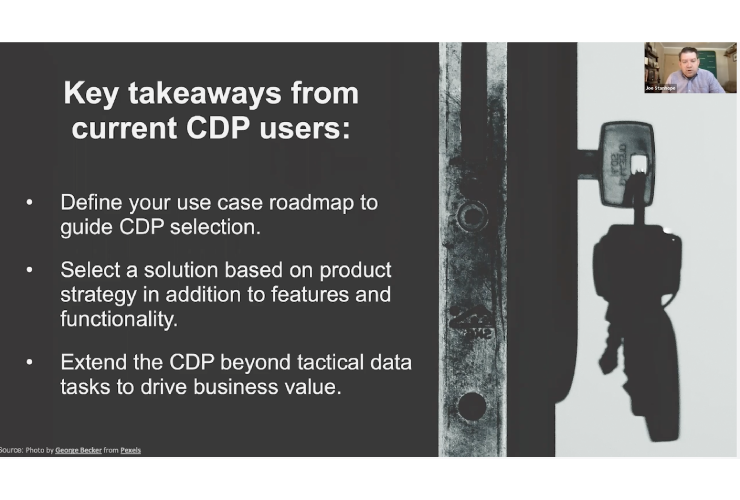
The 2024 Customer Data Platform: What Marketers [Actually] Need to Know about CDPs
There are plenty of articles that teach you all about what a customer data platform (CDP) is and give you a 30,000-foot overview of how a CDP works. These pieces probably list some obvious benefits of unifying your customer data, too.
But if you’d rather dig deep on the state of CDPs in 2024 — and what you really need to know to choose the best customer data platform for your needs — you’re in the right place.
What Does a Customer Data Platform [Actually] Do for a Marketer?
The right CDP delivers measurable business value by helping you to better understand your customers and activate successful marketing campaigns. This requires a handful of key customer data platform capabilities.
Source: Forrester
1. Ingest and integrate data
To provide a unified view of each customer, your CDP must be able to seamlessly process, integrate, and share different types of data across your tech stack. This includes:
- Event-level behavioral data (from websites, apps, customer service, etc.)
- Demographic data
- Transactional data
- Offline and modeled data (like RFM models and propensity scores)
Errors and inconsistencies can pop up as your CDP ingests data from your various sources. Data cleansing and normalizing is therefore important for accuracy. Top CDPs store all of this structured and unstructured data in a scalable, secure, compliant central repository — where it can be processed by AI to unlock new layers of intelligence.
2. Identify customers and manage profiles
The value of a CDP lies in its ability to connect many disparate identifiers from various platforms and devices to the real people they belong to, in real time.
CDPs use deterministic and probabilistic matching to create unified customer profiles for all of your shoppers. This allows you to recognize and engage all consumers on an individual level as they interact with your brand.
The best customer data platforms will also enrich the first-party data in your customer profiles with interests, behaviors, and demographic data to create one unified, comprehensive view that can be used for better marketing — on- and offline.
3. Complete real-time analysis and segmentation
Your CDP uses out-of-the-box data models to understand your customers’ behavior, preferences, and needs. These analytics on customer data give you insight into patterns and allow you to segment your audience by all sorts of variables, such as:
- Demographics
- Buying intent
- Purchase history
- Lifetime value
Real-time segmentation then allows you to define and manage rule-based audience segments on the fly. By instantly adapting to changing customer behaviors, you can create real-time, rule-based campaigns that deliver relevant and timely interactions.
The most advanced customer data platforms also give you the option to create custom data models using machine learning. This capability offers an unprecedented level of enrichment and analysis — and allows you to create hyper-individualized campaigns.
4. Activate data and execute campaigns
Using real-time data from your entire tech stack, you can understand customer behavior and preferences at scale — and execute campaigns accordingly.
For example, your CDP can analyze a customer’s purchasing history, social media activity, and website browsing behavior to create customized product recommendations, promotions, and content.
Rinse and repeat for every customer in your database.
“
How Does a CDP Work [sans Jargon]?
Once you understand the capabilities, it’s easy to understand how a customer data platform works. The platform brings all of the capabilities together in a way that allows you to better understand your customers and execute more successful marketing campaigns.
Here’s what that process looks like with Zeta’s CDP. These steps are taken from the CDP Institute’s RealCDP™ audit certification.
- CDP ingests the client’s customer data from all sources.
- CDP cleanses, standardizes, and unifies the data. Clients can leverage proprietary data assets for optional enrichment (including unknown to known).
- CDP stores all detaled historical and longitudinal data required by users (subject to regulatory constraints).
- CDP provides a unified customer profile, which informs real-time decisioning, analytics, and marketing execution.
- Privacy and consent preferences are stored and upheld throughout the process.
- Zeta’s CDP enables data activation everywhere with native channel execution and syndication to third-party channels and systems.
- The platform incorporates real-time data updates throughout this process.

Cross-industry CDP Use Cases
Unified data sounds great and all…but what’s the impact?
Travel CDP use cases
Many travel companies have been quick to adopt customer data management solutions like CDPs. Unifying customer data allows travel brands to wow customers through use cases like:
- Highlighting specific property amenities based on customer preferences
- Retargeting travel options to abandoned carts or inactive customers
- Coordinating travel messaging across channels
Learn more:
How a Customer Data Platform Improves Travel Experiences
Retail CDP use cases
Most retailers track some customer data, but it’s often siloed in different tools or separated into online and in-person data — making it impossible to get a clear picture of the true customer journey. By unifying customer data with a retail customer data platform, retailers can:
- Find, engage, and grow the highest-value customers
- Activate likely brand ambassadors for a new product launch
- Recommend products and content based on individual behavior
Learn more:
How a CDP can Improve Retail Customers’ Experience
Automotive CDP use cases
The road to buying a car is a long and winding one — especially when you don’t have a clear view of the customer. Unifying data across sources helps automotive companies to:
- Find and engage in-market auto intenders
- Personalize campaigns based on customers’ family size, hobbies, pets, and more
- Diversify financial incentives and promote to the most receptive audience segments
- Guide experiences based on events—like making or returning a purchase, or making a service appointment
“
Watch the case study:
Kia Germany Partners with Zeta to Deliver Higher Quality Leads and Engagement
The CDP Benefits Marketers Expect
The benefits of a well-equipped customer data platform go far beyond capabilities and use cases. At the end of the day, these CDP functions are a means to a more important end: business outcomes.
“
- Higher revenue (58%)
- Improved customer satisfaction (57%)
- Increased customer retention (56%)
- Increased customer acquisition (55%)
Unfortunately, not all CDPs are living up to the hype — 45% of Forrester’s respondents said their current CDP has underperformed against business expectations. While security (54%) and technical support (52%) were the biggest concerns with their current CDPs, marketers were also disappointed with:
- Difficulty analyzing data and finding actionable insights (46%)
- Lack of analytics and reporting functionality (45%)
- Inability to show ROI (37%)
That’s an awful lot of CDP customers that aren’t happy with their platforms. These numbers illustrate the importance of choosing the right tools (CDPs and otherwise) to meet your company’s specific needs.
Learn more:
Forrester: Marketers Need CDP Solutions That Transcend Data Management
CDP vs. DMP vs. CRM—Which Do You Need?
There are a lot of data platforms out there with similar but different roles to play in your tech stack. Let’s take a moment to get clear on all the acronyms.
CDP vs. DMP
The customer data platform is often confused with the data management platform (DMP). The choice of whether to use a CDP or DMP depends on your data needs and what you’re trying to accomplish. But when it comes to unifying your first-party data into useful customer profiles, the CDP reigns supreme.
Technology | Type of Data | Customer Identity | Data Retention |
CDP | CDPs are typically used to store and manage first-party data (owned data). | CDPs are used to store and manage your customer profile data (all the information available about a particular known customer). | CDPs are designed to store data for long-term use and allow you to access customer data over time. |
DMP | DMPs store and manage second- and third-party data (from external sources). | DMPs manage anonymous data that does not contain customer identity information. | DMPs are designed to store data only for a specific period of time. |
Learn more:
CDP vs. DMP: The 3 Main Differences & What’s Right for You
CDP vs. CRM
When considering a CDP vs. a customer relationship management (CRM) platform, it’s important to remember that these tools are complementary. Using these technologies in concert can help you improve customer relationships, increase customer loyalty, and drive revenue growth.
Technology | Use Cases | Users | Data Management |
CDP | CDPs are ideal for delivering personalized marketing experiences, segmenting customers based on chosen attributes, and providing a unified view across touchpoints. | CDPs are designed for non-customer facing roles (e.g. marketing and product teams). | CDP data collection is automated. The platform also automatically unifies and analyzes the data, making it available for real-time access. |
CRM | CRMs are ideal for managing customer interactions, tracking communications, and providing insights into customer behavior and preferences. | CRMs are designed for customer-facing roles (e.g. sales and customer service). | CRM data entry is often manual (although the way data is standardized allows for some personalization of customer interactions and communications). |
Learn more:
CDP vs. CRM: Understanding The Difference
CDP vs. data warehouse
Data warehouses load data from source systems or data lakes and process the data to prepare for analysis or operational tasks (like sending marketing messages). While a data warehouse can theoretically perform the same functions as a CDP, in practice, few data warehouses are designed for that purpose.
An optimal company data architecture will make the best use of each system, assigning some applications to one, some to the other — and sometimes using a combination of features from both.
Technology | Type of System | Strengths | Ideal Use Case |
CDP | A CDP is a ‘system of action’ that uses the company’s data. | ●Real-time access ●Cross-channel identity resolution ●Sophisticated privacy compliance ●Integration with delivery systems | Customer-facing applications are best suited to a CDP. |
Data Warehouse | A data warehouse is a ‘system of record’ that stores the company’s data. | ●Data collection ●Data transformation ●Bulk storage | Analytics and reporting applications are best suited to a data warehouse. |
Learn More:
CDPs and Data Warehouses: Making the Best Use of Both Systems
3 types of customer data platforms
Once you’ve established your need for a CDP, the next step is to understand the types of customer data platforms available to you.
Composable CDPs: Custom solutions
Composable CDPs use a microservices architecture to allow you to create a highly customized customer data platform. You and your team select and combine the components that best meet your needs. The upside is a great deal of flexibility.
The downside is a host of technical barriers. You’ll typically need significant technical resources to select and integrate the right components.
Packaged CDPs: Turn-key solutions
A packaged CDP offers a ready-made solution that’s optimized for specific use cases. Packaged CDPs come with pre-defined features, tools, and integrations that make implementation fast and straightforward. You can get up and running quickly and with minimal development effort.
The biggest drawback of packaged CDPs is their lack of flexibility. You may find yourself restricted by predetermined data models and functionality that does not align with your business needs.
Modular CDPs: A hybrid approach
Modular CDPs bridge the gap between composable and packaged platforms by blending the best elements of both solutions.
Like composable solutions, modular CDPs give you the freedom to customize your platform infrastructure with a wide range of capabilities. You can selectively activate components that are essential to your specific requirements, and you can use flexible data models to wrap around your existing technology stack.
And like packaged tools, modular CDPs offer pre-built integrations and faster time to value.
Learn more:
The Modular CDP: Simplifying the Path to Better Customer Experiences
How to Choose a CDP that Works for You
Composable, packaged, or hybrid — to find a customer data platform that delivers the business outcomes you’re looking for, you need to get the CDP RFP process right. But for the RFP process to deliver a tool your business loves, an extensive checklist won’t cut it.
The [ideal] steps for issuing a CDP RFP
The RFP is just one step in the CDP acquisition process. A complete process starts well before the RFP and includes the following steps.
1. Define your use cases
Properly defined use cases will identify all the capabilities and resources needed to achieve your goals. Building a comprehensive list is important because any missing capability will prevent you from reaching your goals — whether that gap is in the CDP or somewhere else.
2. Convert cases to requirements
This conversion requires a deep understanding of the tasks being executed and the system features that support each task. Make sure to identify requirements that are shared across all use cases, such as identity management and flexible data transformation.
3. Screen vendors against requirements
This initial screening will quickly reduce the huge field of CDP vendors to a manageable number, as many CDPs lack expertise in your industry, offer capabilities that you aren’t looking for, or simply are not sold in your region. This sort of screening can be done using public information or through quick email or phone conversations.
4. Demonstrate qualified products
Some companies issue RFPs before any demos, but this usually means you end up sending RFPs to firms that are not realistic candidates. Initial product demonstrations will give you a general feel for each system, which should eliminate some additional contenders. Just don’t expect an initial demonstration to cover all the details you need to start ranking vendors.
5. Issue the RFP
Once you’ve narrowed your list of contenders to only well-qualified options, it’s (finally) time to issue the RFP. The written document gives you a chance to collect many details that can’t be covered in even a long demonstration. Your RFP responses become the basis for further questions — which can be resolved in writing or in a second round of targeted demonstrations.
6. Scenario demonstrations
In your second round of demonstrations, you should specify what you want to see from the vendor. Ask all vendors to demonstrate the same scenarios, so your buying team can get a clear sense of how the products compare.
7. Supplemental research
In some cases, you may need to complete other types of research — like technical demonstrations, proof of concept implementations, or pilot projects. This is also the time to check with reference clients, clarify pricing questions, and meet prospective vendor team members.
8. Make a decision
Sometimes, a clear winner emerges from the selection process— but you’ll probably end up with several viable candidates. Once the research is complete, many teams will develop a scorecard with all major factors, weight those factors, and score each vendor against each factor.
Learn more:
Getting the Best Customer Data Platform Starts with the Right RFP
What Else to Look for in a CDP?
A CDP partner (not a vendor)
One of the biggest CDP pain points is that many marketers feel the need to devote lots of resources and time on integration. This leads to unnecessary spending on outsourced, third-party vendors who will likely be disconnected from your desired solution and team. Instead, look for a partner that offers native integration and implementation services as part of their core offering.
A platform that will simplify your tech stack
Instead of logging in to different campaigns under different vendors according to strategy, look for a vendor who can consolidate these into one simplified view. Make sure that data can be shared across vendors in this centralized hub so that you can leverage the power of these insights across the scope of your audience.
Data usability
Many tools exist to help you derive value from your customer data. But the flexibility of that data — the ability to access it cleanly and employ it at the speed of business — is the key to operationalizing your data successfully. Make sure your CDP solution has data usability features like:
- Low-code technology that gives marketers access to data sources and insights you would otherwise struggle to obtain and use
- Durable, multi-faceted identity resolution with the depth and scale necessary to resolve anonymous to known users — precisely, persistently, and in real time.
- The ability to augment first-party data with consumer intent signals that reveal which customers and prospects will be most responsive to a campaign
Learn more:
The Business Case for Data Usability
AI: The Future of the Customer Data Platform
As we march into 2024, the top CDPs already have AI-driven functionality integrated into their platforms — and more on their roadmaps. We see four key opportunities for AI to drive better CDP performance in the near future.
1. Building segments
Without AI, marketers use historical data to determine which audiences to target in a given campaign. But AI can identify pockets of people that have a high propensity to respond and/or convert to your offer — and build the ideal segments for you.
“
2. Personalizing the offer
3. Optimizing channels
Speaking of channels, most channel outreach is determined by the consumer opt in. Marketers send emails to everyone who’s opted into their email list. They send SMS messages to everyone opted into their SMS program.
But integrating AI into the CDP can help you predict which channel each person is most likely to respond to. This creates a more positive experience for the consumer, but it also helps marketers reduce spend on touches that are unlikely to drive revenue.
“
4. Optimizing send time
Of course, everyone has different habits and preferences when it comes to opening and responding to brand outreach like emails and text messages. But most brands still send their messages to everyone at the same time.
Adding AI to the equation allows you to find the optimal send time for each recipient, within a defined window. For example AI can find the best time to deploy an email to a single user, within an eight-hour window, based on when they are most likely to open, click, and buy.
Our CDP: Zeta Data Management
“
We might be a little biased, but we’re pretty confident you should include us on that initial RFP list.
Zeta CDP is powered by the Zeta Marketing Platform with solutions specifically designed for data management, omnichannel engagement, marketing automation and more. Contact us for a live demo.
Want to see Zeta in action?






